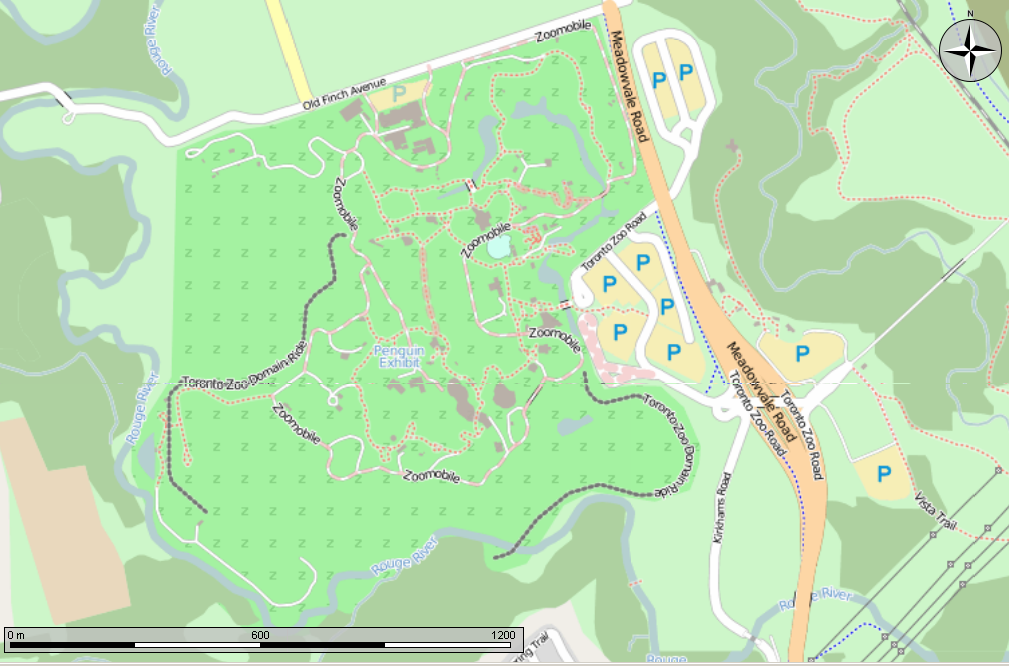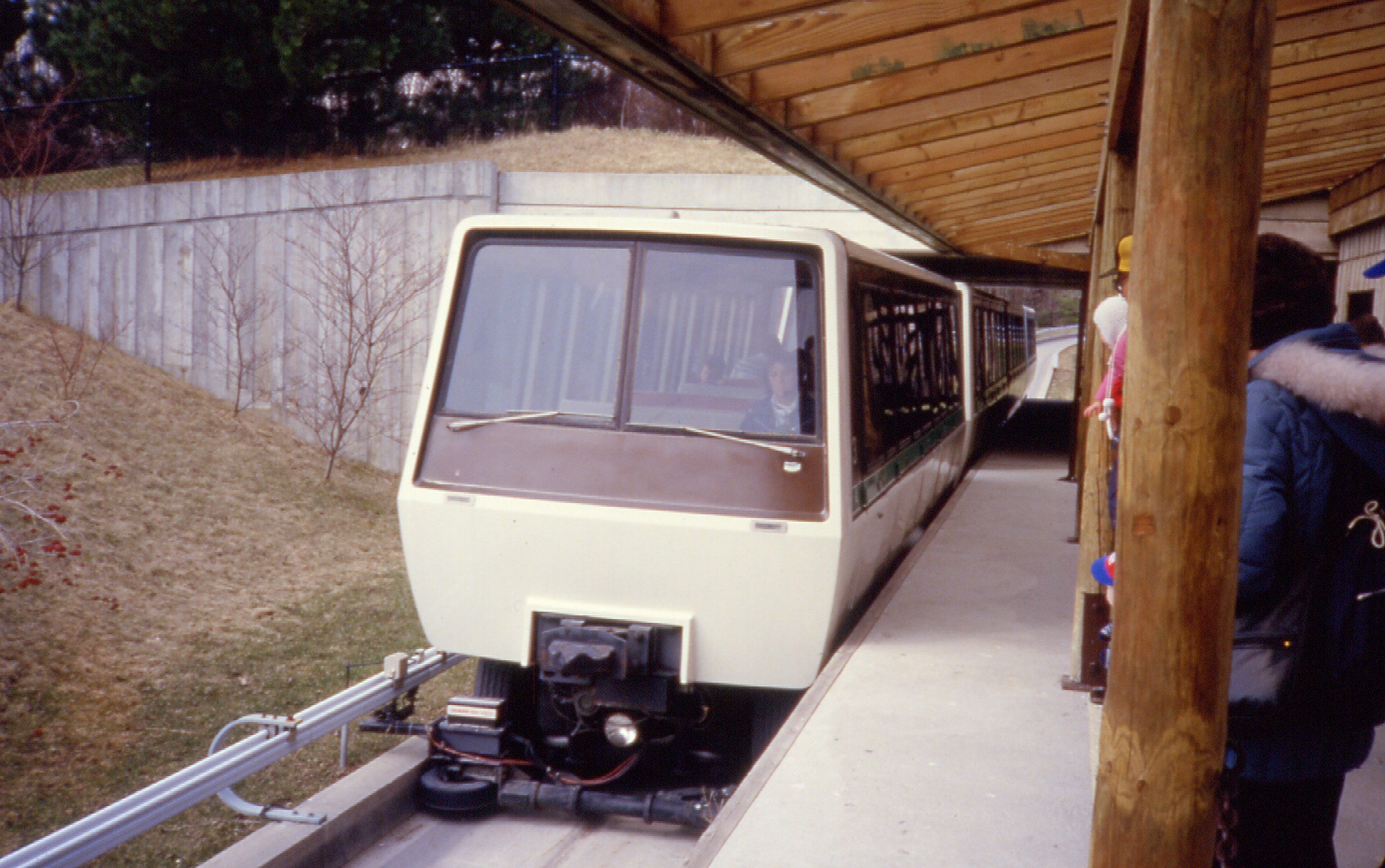Toronto Zoo Domain Ride on:
[Wikipedia]
[Google]
[Amazon]
The Toronto Zoo Domain Ride (also known as the Canadian Domain Ride) was an
 The vehicle was a rubber-wheeled AGT prototype developed by American firm Bendix-Dashaveyor. The train operated on a concrete guideway with electricity supplied by rails located above one side of the guideway. Passengers entered and left via doors located at each double row of facing seats. A secondary set of controls was available in the last car of the train to allow it to be reversed into the storage/service area located towards the north end of the zoo property.
The vehicle was a rubber-wheeled AGT prototype developed by American firm Bendix-Dashaveyor. The train operated on a concrete guideway with electricity supplied by rails located above one side of the guideway. Passengers entered and left via doors located at each double row of facing seats. A secondary set of controls was available in the last car of the train to allow it to be reversed into the storage/service area located towards the north end of the zoo property.
 In addition to being a quick way to travel between sections of the zoo, the ride provided the only way to view several animals, in remote areas of the zoo.
In addition to being a quick way to travel between sections of the zoo, the ride provided the only way to view several animals, in remote areas of the zoo.
Torontoist.com article40 Days on the MonorailVideo about the Domain Ride
{{Toronto passenger railways Passenger rail transport in Toronto Light rail in Canada People mover systems in Canada Railway lines opened in 1976 Railway lines closed in 1994 1976 establishments in Ontario 1994 disestablishments in Ontario
automated guideway transit
An automated guideway transit (AGT) or automated fixed-guideway transit or automatic guideway transit system is a type of fixed guideway transit infrastructure with a riding or suspension track that supports and physically guides one or more dri ...
(AGT) service used to carry visitors between sections, or "domains", of the Toronto Zoo. Though technologically closer to a simple rubber-tired metro, it was almost universally referred to as a "monorail
A monorail is a Rail transport, railway in which the track consists of a single rail or beam. Colloquially, the term "monorail" is often used to describe any form of elevated rail or people mover. More accurately, the term refers to the style ...
".
The train began running in 1976, and closed in 1994, after a train lost power and rolled backwards down the track into a second train, injuring about 30 people. Parts of the line were subsequently taken over by the Zoomobile, an open-air tractor-drawn vehicle with five stations (Main Station, Canadian Domain Station, Africa Station, Americas Station) which had been operating since 1980.
Ride details
 The vehicle was a rubber-wheeled AGT prototype developed by American firm Bendix-Dashaveyor. The train operated on a concrete guideway with electricity supplied by rails located above one side of the guideway. Passengers entered and left via doors located at each double row of facing seats. A secondary set of controls was available in the last car of the train to allow it to be reversed into the storage/service area located towards the north end of the zoo property.
The vehicle was a rubber-wheeled AGT prototype developed by American firm Bendix-Dashaveyor. The train operated on a concrete guideway with electricity supplied by rails located above one side of the guideway. Passengers entered and left via doors located at each double row of facing seats. A secondary set of controls was available in the last car of the train to allow it to be reversed into the storage/service area located towards the north end of the zoo property.
 In addition to being a quick way to travel between sections of the zoo, the ride provided the only way to view several animals, in remote areas of the zoo.
In addition to being a quick way to travel between sections of the zoo, the ride provided the only way to view several animals, in remote areas of the zoo. Moose
The moose (: 'moose'; used in North America) or elk (: 'elk' or 'elks'; used in Eurasia) (''Alces alces'') is the world's tallest, largest and heaviest extant species of deer and the only species in the genus ''Alces''. It is also the tal ...
, white-tailed deer
The white-tailed deer (''Odocoileus virginianus''), also known Common name, commonly as the whitetail and the Virginia deer, is a medium-sized species of deer native to North America, North, Central America, Central and South America. It is the ...
and several other exhibits were not accessible from walking paths. The ride operator would provide commentary on the animals visible from the train during the ride.
Plans to scrap the vehicle and tracks dragged well past 1999. Portions of the guideway have now been removed, while others remain in place (overgrown by vegetation in many areas), but the electrical supply rails have been removed from the remaining portions of the guideway. Three stations remain in place: the Americas station stands behind closed gates, and the Weston station is still accessible for washrooms—the crumbling station platform can be seen from behind the chain barriers.
The Ruins of Weston Station in the Canadian Domain in May 2010.
The Main Station still remains to this day and is now used for several purposes: the Peacock Cafe, and the Main Zoomobile station.
Accidents
During March break of 1991, nine people were injured when a train crashed into the rear of a second train that was stopped between stations. In December of that year, the Metro Zooboard of directors
A board of directors is a governing body that supervises the activities of a business, a nonprofit organization, or a government agency.
The powers, duties, and responsibilities of a board of directors are determined by government regulatio ...
was warned that the monorail needed repair to its braking
A brake is a mechanical device that inhibits motion by absorbing energy from a moving system. It is used for slowing or stopping a moving vehicle, wheel, axle, or to prevent its motion, most often accomplished by means of friction.
Background
...
and propulsion
Propulsion is the generation of force by any combination of pushing or pulling to modify the translational motion of an object, which is typically a rigid body (or an articulated rigid body) but may also concern a fluid. The term is derived from ...
systems in order to prevent future accidents.
On July 11, 1994, 37 people suffered injuries (including broken bones and whiplash) when one train crashed into a second that was in the process of loading. Upon leaving the Weston station, a train would have to climb a hill; however, at the top of the hill, the train lost power and rolled back into the station at an estimated 40 km/h (25 mph), slamming into the front of a second train that was loading. In general, trains would be spaced out by 15–20 minutes; however, due to a larger-than-usual attendance, trains were operating more frequently, and were more crowded too – the first train was carrying 60 passengers. As a result, the Zoo was fined C$43,000, and trial evidence indicated that the ride operator was "inadequately trained to handle the 'unusual situation'".
Zoomobile
The current Zoomobile is a Chance Coach Sunliner tram with four cars set (carrying 103 passengers, 1 driver and 1 tour guide) that replaced the Domain Ride and vehicles have rubber tires running on along paved paths in the zoo. Unlike the Domain Ride, the Zoomobile uses open air cars.Successor
Zoo management has looked into plans for amaglev
Maglev (derived from '' magnetic levitation'') is a system of rail transport whose rolling stock is levitated by electromagnets rather than rolled on wheels, eliminating rolling resistance.
Compared to conventional railways, maglev trains h ...
train operation replacing the Toronto Zoo Domain Ride. The Edmonton-based maglev consortium Magnovate, which includes Magna and Lockheed Martin
The Lockheed Martin Corporation is an American Arms industry, defense and aerospace manufacturer with worldwide interests. It was formed by the merger of Lockheed Corporation with Martin Marietta on March 15, 1995. It is headquartered in North ...
, would pay for the construction, as well as the first five years of operation, while the zoo would pay for the operation afterwards. In November 2018, the deal was modified to the first 15 years of operation. The plan was approved by the Toronto Zoo board in December 2018. Construction was to begin after Magnovate raised sufficient funding to cover the estimated cost. The firm hoped to complete construction by 2021. However, this project is delayed due to the COVID-19 pandemic in Toronto.
See also
* Toronto Zoo * Terminal LinkReferences
External links
Torontoist.com article
{{Toronto passenger railways Passenger rail transport in Toronto Light rail in Canada People mover systems in Canada Railway lines opened in 1976 Railway lines closed in 1994 1976 establishments in Ontario 1994 disestablishments in Ontario